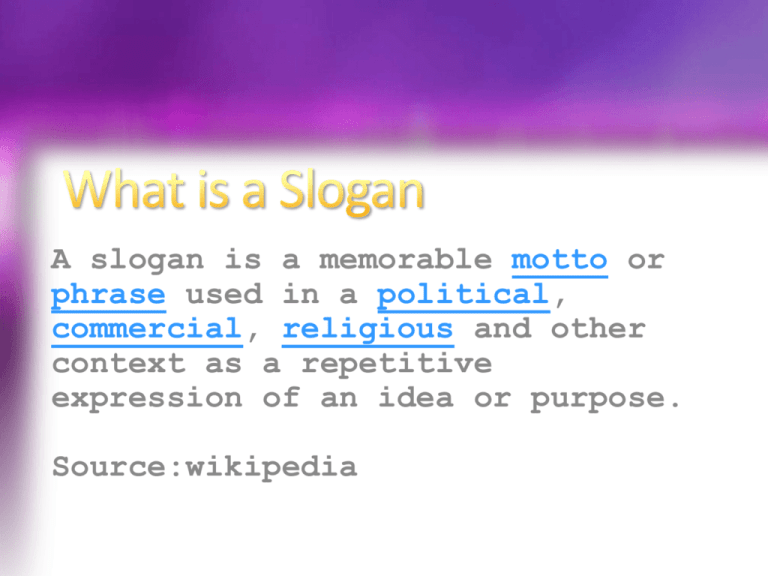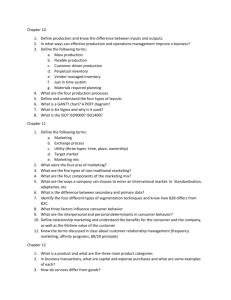
A slogan is a memorable motto or
phrase used in a political,
commercial, religious and other
context as a repetitive
expression of an idea or purpose.
Source:wikipedia
• Descriptive:
• For an uncommon or confusing
product
• a tagline can add clarity.
• Benefit Based:
• help customers visualize value and
focusing attention on a benefit
• Point of Difference:
• In a highly competitive market
place, moving beyond the benefit to
what makes the brand better can
help it stand out.
• Witty Catchphrase
• Personality: establish the
brand's personality.
• Visionary: suggests the image of
the company can be very
Provocative or Motivating:
Telling customers what to do
• why a brand is important can
motivate action
Resources:
http://www.fastcompany.com/articles/20
08/09/the-best-advertising-slogans-ofall-time.html?page=0%2C0
http://www.adglitz.com/2010/08/24/topn-best-100-ad-slogans-taglinespunchlines-advertising-campaigns/
Lesson 1-1 pg 4: Needs and Wants
Three criteria must be met for
communication to be classified as
advertising:
1. The communication must be paid
for.
2. The communication must be
delivered through mass media.
3. The communication must be
attempting to persuade.
1–6
Copyright © 2006
Thomson Business and
Economics. All rights
reserved.
Individuals own the resources and
run the business (not the
government)
Purpose is to earn profit
Dictated by Supply and Demand
Supply
Demand
Supply increases with
Price increases
Demand increases as the
price decreases
CONSUMER: someone who uses products
What consumer decisions did you make
today before leaving home?
NEED: something you cannot live
without
EX?
WANT: something that you would like
to have but can live without
EX?
How much do you
need?
Food at grocery store
vs. dining at
expensive restaurants
Style vs. Function
Coat from Abercrombie
vs. Coat from Kohl's
What’s the Difference?
•Defined: everything that affects or
is affected by consumer consumption
(use)
•Impacts purchasing decisions
•Need it now or buy on sale later or
online?
•Functional or Emotional?
•Ex
1.Design a market Strategy
2.Stand out of the Crowd
3.Contribute to revenue and
profit earning
4.Enhance customer
satisfaction
Used to Promote
and distribute a
Product
Define a difference
between product and other
similar products-must
think it is different
EXAMPLE
Name Brand vs. Store
Brand
Define the market (type of
person) that would buy the
product and design your
advertisement for a
specific individual
Ex Car vs. Truck
Advertisement should help
generate sales/increase
sales if successful
Ad should continue to reinforce the
consumers reason for purchasing the
product
Functional
Emotional
Reg. washer and The product
dryer or Steam
makes you feel
Washer/Dryer?
proud or
satisfied
Cheap tires
(don’t last as Toyota vs. Lexus
long) vs.
Same Head
Expensive tires
company
that last
longer
House vs.
apartment $$
Consumers spend 98% of income
How much is saved for every $100
earned?
Most spend more than they earn?
Credit Cards/Loans
Results: financial trouble (take
accounting!)
Bankruptcy
How do your needs and wants
determine what you buy?
There were 1,408,041 bankruptcy
filings in 1998. In 1990,that number
was 718,107.
Calculate the percent of increase in
bankruptcy filings between 1990 and
1998.
Hint***
To determine the percent of increase, first
subtract the number of filings from 1990 from
1998, then divide the results by the number
1990 filings
1408041-718107
=.96 or 96%
78107
Bankruptcy increased by 96% from 1990 to 1998
How do you choose what you buy?
Advertisement:
•a paid public announcement
•emphasis on desirable qualities of
the product or service
• intent to persuade you to buy an
product or service
•What Makes a Great Ad
Three criteria must be met for
communication to be classified
as advertising:
The communication must be paid
for.
The communication must be
delivered through mass media.
The communication must be
attempting to persuade.
1–23
Copyright © 2006 Thomson
Business and Economics. All
What is this image advertising?
Consumers are people who buy a
product
•
for their own or someone else’s
personal use.
Reach
• total number of different people
or households exposed to an
advertising message during a given
time, usually four weeks.
Frequency
• number of times the same person or
household is exposed to an
advertising message in a specified
time span.
• Mass media,
• Medium =
• Radio
Channel of
• Television
Communication
• Paid method of
presenting an
ad to its
target market
•
•
•
•
•
Newspapers
Magazines
Internet
Billboards
direct mail
• Word of Mouth (WOM)
• communication medium
• not an advertising
medium
• Traditional Media, newspaper,
television, and radio
• Addressable Media, direct mail and
email
• Interactive Media, kiosks and the
Internet
• Non-traditional Media, shopping
carts, blimps, videos/movies,
sponsorships
• newspapers and magazines
• that sells advertising space to a
variety of advertisers
• Most newspapers are local
• Most magazines are national but publish
localized and specialized editions
• Directories-Yellow pages;
• school or church newspapers and
yearbooks;
• programs used at sporting events and
theatrical performances
Includes radio, television, and
cable broadcasts
U.S. Statistics
More than 1,000 local commercial TV
stations, in addition to major
networks, including ABC, CBS, NBC, and
Fox
Nearly 10,000 local radio stations,
More than 10,000 local cable systems
Cable provides channels with
specialized offerings, such as QVC
and AMC, in addition to major
networks, such as USA, A&E, and CNN
Allows the audience to participate
actively and immediately
mass media less effective
Internet creates instant access for
even small companies, who could
not afford to advertise in
traditional forms of media
Outdoor advertising =
billboards
Transit advertising =
bus, taxi, subway
Effective and inexpensive
media to reach the public
in the retail neighborhood
advertising directly to prospective
customers without using one of the
commercial media forms.
Ads may be simple sales letters,
complex packages of coupons,
brochures, samples, or other
devices designed to stimulate a
response.
Direct mail using the postal service
is most expensive, but also most
effective because marketers can
target customers directly without
• previews in movie theaters.
• Computers dial telephones and
deliver messages by simulating
speech and playing a prerecorded
message.
• Computers play prerecorded sales
messages while callers are on
hold.
1.
2.
3.
4.
5.
1–35
Brand Advertising
Informative Advertising
Comparative Advertising
Defensive Advertising
Persuasive Advertising
Copyright © 2006 Thomson
Business and Economics. All
•Brand-purpose to remember the brand
not just the product
•Ex?
•Informative-teaches you about the
benefits of a product
•Ex?
•Defensive-The losing product
defending itself
•Ex?
•Persuasive-Product makes you happy
or more glamorous or more athletic
Gross Domestic Product
Business Cycles
Competition
Prices
Value
1–37
Copyright © 2006 Thomson
Business and Economics. All
Coordinated
promotional
activities
reinforce one
another.
C
o
u
p
o
n
s
1–38
Copyright © 2006 Thomson
Business and Economics. All
BRAND ADVERTISING
http://www.metacafe.com/watch/
424246/aarps_new_advertising_cr
eative_focuses_on_the_needs_of_
multiple/
http://www.youtube.com/watch?v=Gb9vOp7
wCqQ
INFORMATIVE
ADVERTISMENT
http://www.youtube.com/watch?v=ZTpXh33M
beg&feature=related
PERSUASIVE ADVERTISEMENT
To promote Reebok’s night safety running shoes in Singapore,
this ad targets consumers through a purely illustrative
advertisement, overcoming any language barriers.
InformativeStudent Example-Purrell
http://vimeo.com/
http://www.youtube.com/
23883753
watch?v=y26IPHcdY2s&s
afety_mode=true&persis
t_safety_mode=1&safe=
active
Mac Guy
PC Guy
DEFENSIVE ADVERTISING
Informative- http://vimeo.com/23883753
Defensive-provides info about
products strengths and weaknesses
•Understanding consumer behavior
•Successful products can often be
traced to great advertising
•Great Products that fail often are a
result of poor advertising
•Repeat business and reputation
IMPORTANT!
Lesson 1.2
1. How do you look?
2. Where do you live?
3. What do you think?
Your Values-make own decisions and
priorities
What two version of yourself do you
see in advertisements?
Pros
Cons
• Educates consumer • Biased
• Raises the
• Buy better
standard of living
products
for some
• Pay lower prices
• Spend less time
shopping
• Makes Products
Cheaper
Advertising
Increases the cost
of a product
Who pays for the
Advertising also
increase in cost?
LOWERS the cost
when the demand
is increased
When more items are
produced the cost
to produce
decreases
Why is the newest technology used
for television commercials?
Discuss with partner
Answer
Advertisers want consumers to notice
their commercials. However, viewers
quickly become accustomed to special
effects it is necessary to continually use
the newest technology to generate the
same level of interest.
Lesson 1.3
1. Must be paid for
2. Deliverd by mass media
3. Attempt to persuade into an action
or belief




